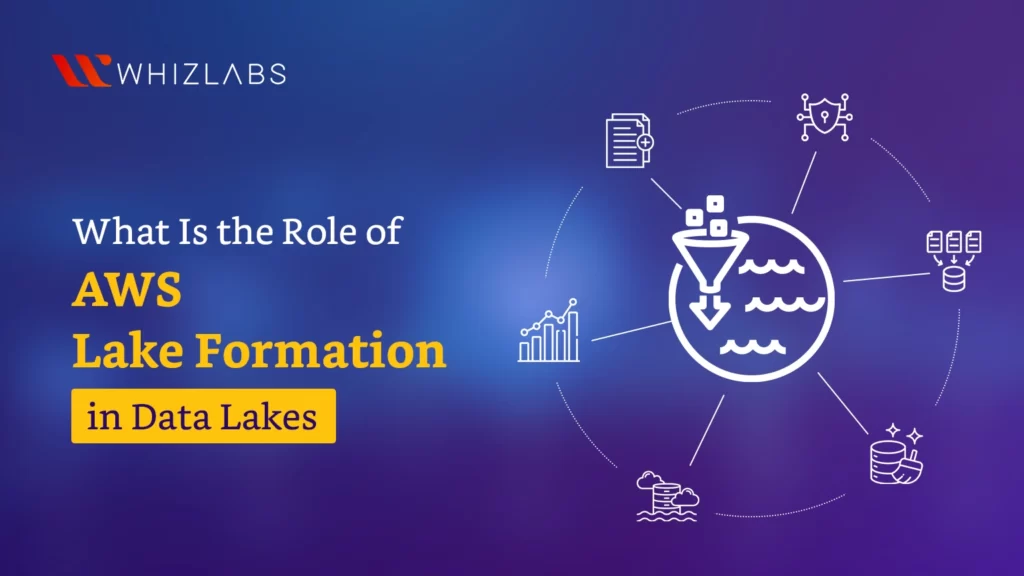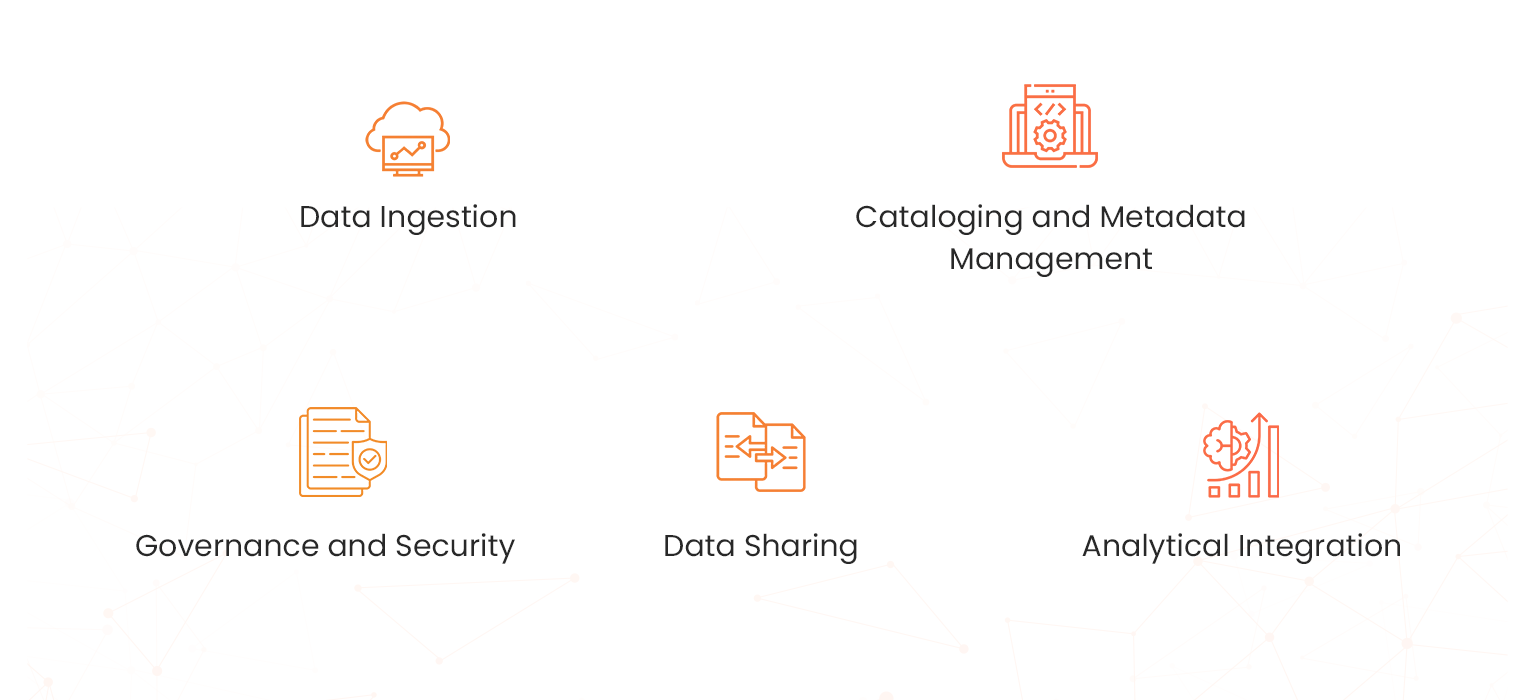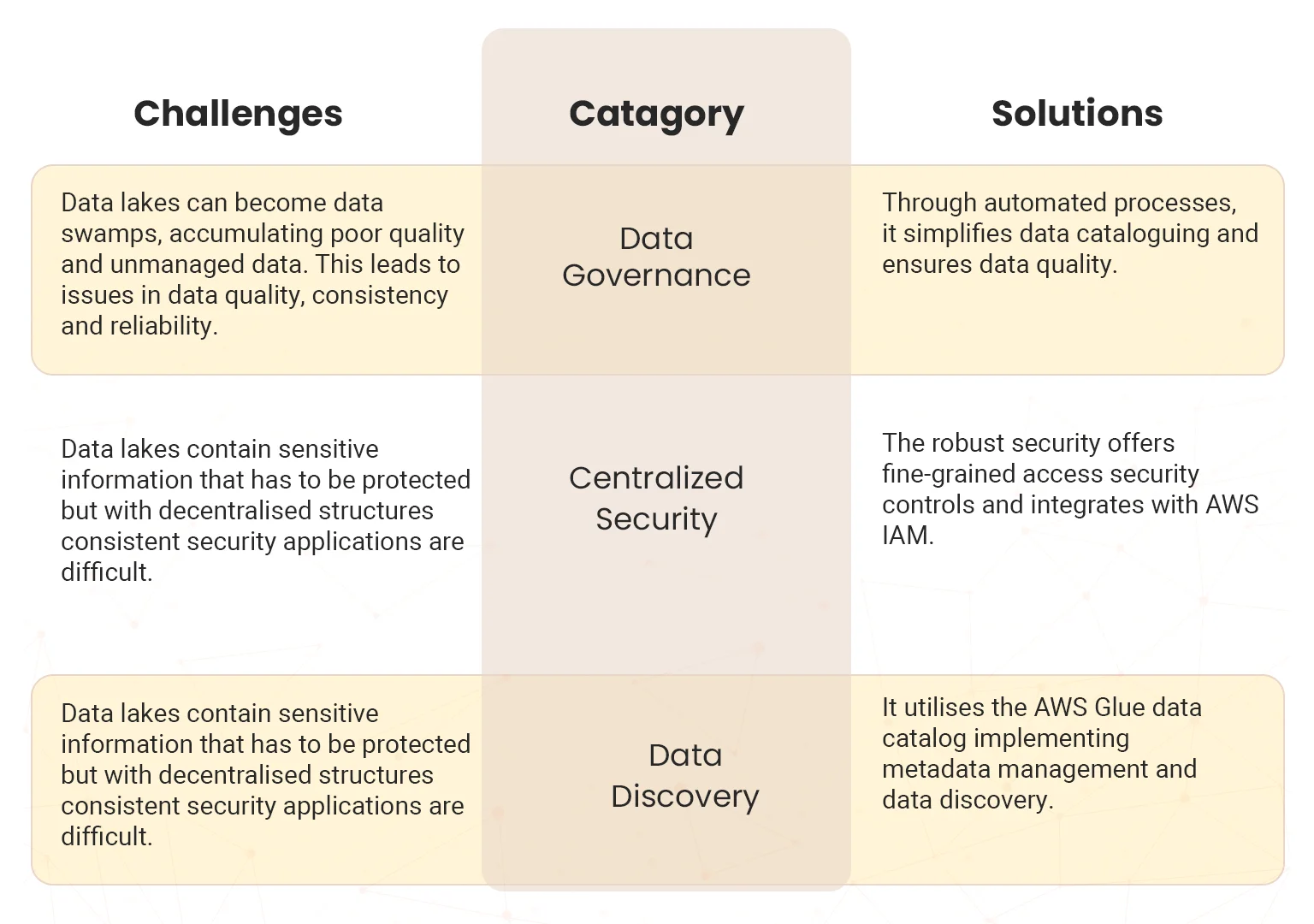In this blog, we have discussed the major roles of AWS Lake Formation that protect data swamps for AWS Certified Data Engineer Associate Certification – DEA-C01. This favors the candidates preparing for DEA C01 to understand the importance of data protection in the cloud. Scroll up to learn more.
What Is Data Lakes?
A centralised repository to store vast amounts of data in its native and unprocessed format. Data Lakes unlike the traditional storage system, it’s more of a warehouse, but data lakes are designed to handle multiple volumes of data differing in type, structure and schema. This makes it easy for organizations to store and analyse multiple data sources from one avenue at scale.
Almost 85% of big data projects in organisations today fail due to poor planning, governance, and execution in Data Lakes. Organisations struggle with data governance, security, and quality issues. The main role of AWS Lake Formation in data lakes is to secure productivity.
The main purpose of Data Lakes Formation
- Analyse Big Data with ML and predictive analytics in real-time for its ability to store.
- Produce Data Science Applications to explore, prepare and analyse diverse data sets.
- Improve Business Agility contributing towards decision making.
Characteristics of Data Lakes
- Shema-on-Read : The data is stored in its original format and it is structured only when accessed for analysis. It offers flexibility for diverse use cases.
- Supporting all Data Types: Data Lakes supports different types of data which are structured, semi-structured and unstructured like database tables, images, video, JSON, XML, etc.
- Scalability: Embodies a high level of scalable architecture like Cloud object storage or distributed systems that accommodate petabytes cost-effectively.
- Flat Architecture: It’s not like a Hierarchical data warehouse, the data lakes use flat storage models allowing easy and flexible access to raw data storage.
- Staged Zones: The data lake organises data into raw, cleansed, and curated zones to meet the requirements of different use cases.
Overview OF AWS Lake Formation and Its Significance
The AWS Lake Formation is a dedicated service that manages the design and simplifies the creation, governance, and operation of Data Lakes. It is a part of AWS Certified Data Engineer Associate Certification, sharing insights on how to potentially automate key tasks like data ingestion, cleaning, cataloguing, and providing secured access to sensitive data. The AWS Lake Formation addresses inconsistent data quality, Lack of governance, long time to value, and other common challenges, therefore contributing to the improvement of the Organization.
- Implements fine grainer security control
- Seamless integration with analytical tools
- Cut down the complexity of managing data groups.
Put together the AWS Lake Formation empowers businesses to deliver focussed and designated actionable insights rather than grappling with other infrastructural challenges – setting the base for strong modern data architecture.
Revolutionary Aspects of AWS Lake Formation In Data Lake
The AWS Lake Formation best practices are truly revolutionizing data lakes in long-standing data management challenges. Here is how they do
-
Centralised Governance and Security
- Fine-Grained Access Control: AWS Lake Formation provides granular Permission at the column, row, and cell levels. This protects the sensitive data while it can still be accessible to authorised users.
- Data Auditing and Compliance: Offering comprehensive auditing capabilities helps the organization meet regulatory requirements through tracking access data and interactions.
-
Simplified Data Sharing
- Internal and External Sharing: Lake Formation provides a secured data-sharing option across multiple AWS accounts and organizations. It facilitates Collaboration promotions without compromising security.
- Data Mesh and Exchange: Creates data mesh and integrates with AWS data exchanges bringing in efficient data sharing without unnecessary movements.
-
Efficient Data Management
- Automated Data Ingestion and Cataloging: Lake formation has a simplified process for importing data from different sources and catalogues with AWS Glue Data catalogue which makes data discovery easier.
- Data Quality and Transformation: Enhancing data quality through Machine learning record matching and de-duplication. It supports data transformation into formats like Parquet with quick analysis.
Key Roles Of AWS Lake Formation
As AWS Lake formation automates key tasks like Ingestion, cataloguing, and governance, it completely simplifies the process of creating, managing and securing data lakes. And here are the major roles of AWS Lakes Formation.
-
Data Ingestion:
The Lake formation first identifies the existing data course, and then it imports the data into the Data Lake. It also supports Bulk and incremental loading making data movements more efficient.
-
Cataloging and Metadata Management:
The AWS Glue crawler extracts metadata from ingested data and stores it in the AWS Glue Data Catalog, which provides a central repository for metadata. It also enables easier data discovery and management.
-
Governance and Security:
The Lake Formation implements fine-grained access control for every column, row and cell level with a relational Database-style permission model. This later integrated with IAM policies and enforced security across Amazon S3 and other services.
-
Data Sharing:
The Lakes facilitates secured internal and external data sharing for AWS Account or organisations without requiring any data movements.
-
Analytical Integration:
The AWS Lake Formation seamlessly integrates with analytical tools which provide secured access to data for query and visualization.
Different Challenges In Data Lakes
With the ability to store and analyse vast amounts of data, Dat lakes do face several challenges hindering the effectiveness of the operation.
How To Address These Challenges With AWS Lake Formation?
- Automated Data Governance: Through automated processes, it simplifies data cataloguing and ensures data quality.
- Centralised Security: The robust security offers fine-grained access security controls and integrates with AWS IAM.
- Enhanced Data Discovery: It utilises the AWS Glue data catalog implementing metadata management and data discovery.
All of these features contribute to the transition of the organization with its data lakes into a well-governed, highly secured and at the same time accessible repository that favours precise analysis and decision-making.
Real-World Use Case Of AWS Lake Formation Permissions
- Data Governance for Financial Institutions: Banks using Lake Formation enforce strict access controls on sensitive data which enables analysts to easily query aggregated data insights securely.
- Retail Analytics: In retail, it consolidates sales, inventory, and other customer behaviour data with a centralised data lake. It enables secured and curated sharing of data with the teams.
- Healthcare Data Compliance: With AWS Lakes with row-and-cell-level security, the healthcare provider ensures compliance with HIPAA regulations which protects patient records.
- Cross-Organization Collaboration: With centralised control over permission when a multi-national company uses Lake formation to share governed datasets across subsidiaries it’s done safely, and secured.
How To Set Up AWS Lake Formation
-
Set Up Permission
First, assign the Data Lake administrator role in IAM and configure access either using IAM Allowed Principals or custom IAM policies.
-
Register Data Sources
Then register in the Amazon S3 bucket that contains raw data with lake formation. And also you can connect with external databases if required.
-
Catalogue you Data
Using the AWS Glue crawler, scan your datasets and populate the catalogue with metadata and other definitions.
-
Define Fine Grain Permission
Now create an LF-tag to assign the table or column and user the tag-based access control which defines the access specifics of the datasets.
-
Provide Analytic Access
Grant the required permissions for tools like Amazon Athena, etc for analysis and you can also query your data securely with temporary credentials provided by Lake Formation.
-
Monitor and Audit
Vitalise the Built-in auditing feature and track access to the whereabouts of the data. Also, ensure the compliance is met with the regulatory requirements by reviewing the logs.
You can also check out the sandboxes and hands-on labs we have, to explore your practical knowledge in Data engineering with AWS Certified Data Engineer Associate Certification.
To Sum Up.
AWS Lake Formation simplifies building and managing data lakes, automates ingestion, cataloguing, integrates cross-function effectively, and analyses efficiently for organisation scalability. With AWS-certified Data Engineer Associate certification (DEA-C01), perceive ahead in your Cloud journey building Data Lakes without any swamps. With this game-changing modern architecture, it’s now your time to step up your skills, and DEA-C01 certification is a great way to move forward. Get started now, Whizlabs SMEs are here to support you.
- What Is the Role of AWS Lake Formation in Data Lakes? - April 17, 2025
- What will you learn from AZ-900 certification? - April 11, 2025
- What Are the Key ML Models in Databricks AI Certification? - March 25, 2025
- What Are AZ-800 Security Strategies for Hybrid Cloud? - February 28, 2025
- How AZ-140 Boosts Your Cloud & VDI Expertise? - February 19, 2025





